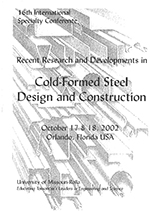Session Dates
17 Oct 2002
Abstract
A full-scale experimental study on the structural performance of load-bearing wall panels made of cold-formed steel frames and boards is presented. Six different types of C-channel stud, a total of 20 panels with one middle stud and 10 panels with two middle studs were tested under vertical compression until failure. For panels, the main variables considered are screw spacing (300 mm, 400 mm, or 600 mm) in the middle stud, board type (oriented strand board - OSB, cement particle board - CPB, or calcium silicate board - CSB), board number (no sheathing, one-side sheathing, or two-side sheathing), and loading type (1, 3, or 4-point loading). The measured load capacity of studs and panels agrees well with analytical prediction. Due to the restraint by rivet connections between stud and track, the effective length factor for the middle stud and the side stud in a frame (unsheathed panel) is reduced to 0.90 and 0.84, respectively. The load carrying capacity of a stud increases significantly whenever one- or two-side sheathing is used, although the latter is significantly more effective. It is also dependent upon the type of board used. Whereas panels with either OSB or CPB boards have nearly identical load carrying capacity, panels with CSB boards are considerably weaker. Screw spacing affects the load carrying capacity of a stud. When the screw spacing on the middle stud in panels with one-side sheathing is reduced from 600 mm to 300 mm, its load carrying capacity increases by 14.5 %,20.6% and 94.2% for OSB, CPB and CSB, respectively.
Department(s)
Civil, Architectural and Environmental Engineering
Research Center/Lab(s)
Wei-Wen Yu Center for Cold-Formed Steel Structures
Meeting Name
16th International Specialty Conference on Cold-Formed Steel Structures
Publisher
University of Missouri--Rolla
Document Version
Final Version
Rights
© 2002 University of Missouri--Rolla, All rights reserved.
Document Type
Article - Conference proceedings
File Type
text
Language
English
Recommended Citation
Wang, J.; Tian, Y. S.; Lu, T. J.; and Barlow, C. Y., "An Experimental Study on the Load Carrying Capacity of Cold-formed Steel Studs and Panels" (2002). CCFSS Proceedings of International Specialty Conference on Cold-Formed Steel Structures (1971 - 2018). 2.
https://scholarsmine.mst.edu/isccss/16iccfss/16iccfss-session7/2
An Experimental Study on the Load Carrying Capacity of Cold-formed Steel Studs and Panels
A full-scale experimental study on the structural performance of load-bearing wall panels made of cold-formed steel frames and boards is presented. Six different types of C-channel stud, a total of 20 panels with one middle stud and 10 panels with two middle studs were tested under vertical compression until failure. For panels, the main variables considered are screw spacing (300 mm, 400 mm, or 600 mm) in the middle stud, board type (oriented strand board - OSB, cement particle board - CPB, or calcium silicate board - CSB), board number (no sheathing, one-side sheathing, or two-side sheathing), and loading type (1, 3, or 4-point loading). The measured load capacity of studs and panels agrees well with analytical prediction. Due to the restraint by rivet connections between stud and track, the effective length factor for the middle stud and the side stud in a frame (unsheathed panel) is reduced to 0.90 and 0.84, respectively. The load carrying capacity of a stud increases significantly whenever one- or two-side sheathing is used, although the latter is significantly more effective. It is also dependent upon the type of board used. Whereas panels with either OSB or CPB boards have nearly identical load carrying capacity, panels with CSB boards are considerably weaker. Screw spacing affects the load carrying capacity of a stud. When the screw spacing on the middle stud in panels with one-side sheathing is reduced from 600 mm to 300 mm, its load carrying capacity increases by 14.5 %,20.6% and 94.2% for OSB, CPB and CSB, respectively.



